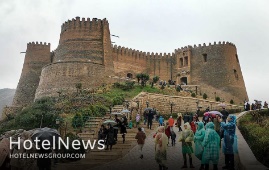
The construction of a fence wall has been completed around Falak-ol-Aflak fortress, an imposing monument of Sassanids, which dominates the capital city of Khorramabad in western Iran. “The wall has been constructed based on the original model and historical documents,” Lorestan province’s tourism chief said on Sunday. “Moreover, traditional materials have been used in the recent construction that has harmony with the fortress.” The unmissable eight-towered monument seems particularly dramatic when floodlit at night, offering picturesque views of its encircling crenelated battlements. Lorestan is a region of raw beauty that an avid nature lover could spend weeks exploring. The region was inhabited by Iranian Indo-European peoples, including the Medes, c. 1000 BC. Cimmerians and Scythians intermittently ruled the region from about 700 to 625 BC. One of the most prominent archaeological findings of the fertile region is the ancient “Luristan Bronzes”, which are noted for their eclectic array of Assyrian, Babylonian, and Iranian artistic motifs. Lorestan was incorporated into the growing Achaemenid Empire in about 540 BC and successively was part of the Seleucid, Parthian, and Sassanid dynasties.
Create: Nov 15, 2021 Edit: Nov 15, 2021 Regional News
Iran must rebuild trust with the global tourism market, the Head of the Iranian Tour Operators said on Sunday. The level of Iran’s health security and vaccination against coronavirus should be advertised internationally to gain further trust from the global tourism market, Ebrahim Pourfaraj said. The health and safety level in Iran is a concern for foreign tourists, he noted, ISNA reported. It is the responsibility of the Ministry of Foreign Affairs, embassies, economic and cultural attaches, and ministries of health and tourism to inform the world about Iran’s [great achievements in] public vaccinations, the official added. During the pandemic, Iran has maintained contact with global tourism markets and companies that worked with the country in the past, especially since virtual communication and meetings have been held, he mentioned. “Following the resumption of the tourist visa, visitors from Russia and France have traveled to Iran and we are currently expecting a smaller number of tourists in Iran due to the current situation in the world,” he explained. There is, however, speculation that in the spring of 2022, the next high season of travel to Iran, the number of tourists and trips will increase, he added. In January, the official announced that international tourism flow to Iran will return to normal in 2022. Although there are requests for traveling to Iran in the current year (2021), most travel agencies and tour operators believe that the flow will go back to normal in the next year, he said. Beginning mass vaccination against the coronavirus will provide better and safe conditions for international travels in 2022, he added. Last November, the World Tourism Organization announced that international tourist arrivals to Iran plunged 72% during the first eight months of 2020 when compared to 2019, highlighting the severe impact of COVID-19 as the main factor. Some experts believe Iran is still somehow “unknown” for many potential travelers due to Western “media war”. The ancient land is potentially a booming destination for travelers seeking cultural attractions, breathtaking sceneries, and numerous UNESCO-registered sites. Under the 2025 Tourism Vision Plan, Iran aims to increase the number of tourist arrivals from 4.8 million in 2014 to 20 million in 2025.
Create: Nov 15, 2021 Edit: Nov 15, 2021 Regional News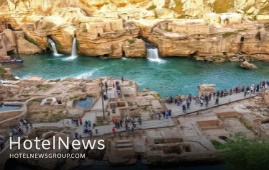
The UNESCO-registered Shushtar Historical Hydraulic System has been closed to visitors amid safety concerns after its western side was announced to be “unstable”. “Shushtar Historical Hydraulic System was closed to the public until further notice due to the unstable conditions of the western wall,” Mehr reported on Sunday. “Cultural heritage experts have warned for years about the instability of this part of the World Heritage,” the report said. Earlier in October, a local official announced that leakage of the site, which is known globally as a masterpiece of creative genius, is an immediate concern and needs to be restored. “To prevent water leakage in the historical structure, which could result in its destruction, short-term measures are taken,” the official said, Mehr reported. Studies and research are being conducted and meetings with consulting engineers are underway to find a way to cause the least damage to this ensemble, the official added. The ancient hydraulic system comprises bridges, weirs, tunnels, canals, and a series of ancient watermills powered by human-made waterfalls. It is named after an ancient city of the same name with its history dating back to the time of Darius the Great, the Achaemenid king. Inscribed on the UNESCO World Heritage list in 2009, the Shushtar Historical Hydraulic System may testify to the heritage and the synthesis of earlier Elamite and Mesopotamian knowhow. According to UNESCO, the ensemble was probably influenced by the Petra dam and tunnel and by Roman civil engineering. The property is as rich in its diversity of civil engineering structures and its constructions as in the diversity of its uses (urban water supply, mills, irrigation, river transport, and defensive system). The Shushtar Historical Hydraulic System testifies to the heritage and the synthesis of earlier Elamite and Mesopotamian knowhow; it was probably influenced by the Petra dam and tunnel and by Roman civil engineering. “The hydraulic system has been considered a Wonder of the World not only by the Persians but also by the Arab-Muslims at the peak of their civilization,” according to the UN cultural body. Furthermore, one of its main canals is a veritable artificial watercourse that made possible the construction of a new town and the irrigation of a vast plain, at the time semi-desert. UNESCO says that the Shushtar Historical Hydraulic System demonstrates outstanding universal value as in its present form, it dates from the 3rd century CE, probably on older bases from the 5th century BC. It is complete, with numerous functions, and large-scale, making it exceptional.
Create: Nov 15, 2021 Edit: Nov 15, 2021 Regional News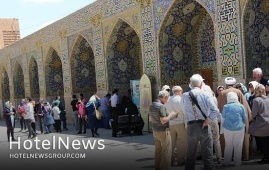
A number of Russian travel agents and tour operators have recently arrived in Iran for a week-long familiarization tour, Mehr reported on Friday. The group, which entered the Islamic Republic on Thursday through Imam Khomeini International Airport, was scheduled to travel earlier this year following the implementation of Iran-Russia visa waiver for group tours; however, because of coronavirus restrictions, they were forced to postpone the journey, the report added. Supported by Mahan Airlines, the group will tour the southern cities of Kerman, Mahan, Shiraz, and central city of Isfahan as well as the UNESCO-registered Lut Desert in the barren heartland of Iran. The tour will be held observing strict health protocols and social distancing rules. Earlier in June, the former Iranian tourism minister Ali-Asghar Mounesan finalized work on a bilateral visa-free agreement for tourist groups with Russia. In 2017, former Iranian President Hassan Rouhani and his Russian counterpart Vladimir Putin inked a visa-free agreement for tourist groups. A joint technical committee has been developing an action plan for the previously agreed visa-free travel arrangements since then, in order to put the agreement into effect. However, the outbreak of the coronavirus put a halt to the agreement. Based on the 2017 agreement tour groups of 5 to 50 people heading to [easternmost parts of] Russia from Iran or vice versa are granted a visa-free stay of up to 15 days. Back in May, Mostafa Sarvari, who presides over the tourism marketing and advertising office of the Iranian Tour Operators Association, announced many Russian tourists are eager to travel to Iran, recounting his Russian counterparts. “Many [potential] Russian travelers are motivated to visit novel and lesser-known destinations such as Iran that could be a safe and attractive destination,” he said. “According to Russian tourism experts, the feedback from Russian tourists who have traveled to Iran has been very positive, and its reflection, especially on social media, has caused a great deal of enthusiasm and interest.” According to Ebrahim Pourfaraj, who heads the Iranian Tour Operators Association, rounds of negotiations have been held between Iranian tour operators, travel marketers, and their Russian counterparts. “We’ve been commenced talks with some Russian travel agents to put Iranian destinations on their itineraries…. And the Iranian Tour Operators Association has also entered negotiations with Russian unions for outbound tours to attract more travelers from Russia. Pourfaraj says the majority of potential Russian travelers are unaware of the vast tourist attractions that exist in every corner of Iran. “The fact is that Iran’s political and economic relations with Russia are considered as good, but this has nothing to do with attracting tourists because it is directly connected with the Russian people. It is the Russian people who must choose Iran as their destination.” Maya Lomidze, executive director of the Association of Tour Operators of Russia, had told Sputnik that the visa agreement may significantly surge the tourist flows between the two countries, just like it happened when a similar deal was signed between Russia and China. The flow of Iranian tourists to Russia increased by 50-70 percent following the operation of direct flights that connect Iran to St. Petersburg, Moscow, and Sochi, she said. Iran is taking proactive measures in line with the long-term goal of 20 million tourists by 2025.
Create: Nov 9, 2021 Edit: Nov 9, 2021 Regional News
The Federal Communications Commission has authorized a satellite internet project from Boeing first proposed in 2017. Boeing can now move forward with building, launching, and operating its own broadband internet network from space, joining its main aerospace competitor SpaceX. Boeing’s plan involves placing 132 satellites into low Earth orbit at an altitude of 1,056 kilometers (about 656 miles). Another 15 will be launched to “non geostationary orbit” at an altitude between 27,355 and 44,221 km (16,998 to 27,478 miles). The company says it wants to use the satellites to offer “broadband internet and communications services to residential consumers, government and business users in the United States, Puerto Rico and the US Virgin Islands” while the network gets built out, and on a global basis once it’s complete. All 147 satellites would broadcast in the V-band, a higher-frequency slice of the wireless spectrum than the Ka and Ku bands used by SpaceX’s Starlink network or Amazon’s yet-to-be-deployed Project Kuiper satellites. Using V-band could allow for faster data transfer rates but runs a greater risk of interference because the higher frequencies have more trouble penetrating solid objects. (SpaceX has plans to use the V-band in some future satellites, and so does OneWeb. The Ka and Ku bands are also used by satellites that provide in-flight internet on commercial airlines.) SPACEX HAD TOLD THE FCC IT WAS CONCERNED BOEING’S NETWORK WOULD CROWD LOW EARTH ORBIT SpaceX has previously expressed concern that Boeing’s proposal to launch into already-crowded low orbits could increase the risk of a collision with other satellites. In 2019, SpaceX said to the FCC that it believed Boeing’s network would create a “clear danger of harmful interference,” according to Reuters. SpaceX’s Starlink satellites orbit the Earth at an altitude of around 550 km (roughly 342 miles), which is around where OneWeb’s internet satellite constellation can be found (and where Amazon’s satellites will go once they launch). SpaceX and OneWeb narrowly avoided a collision earlier this year. Boeing now has six years to launch half of its satellite constellation and nine years to deploy the entire network. The company had asked the FCC to loosen those requirements — it wanted to only commit to launching five satellites in the first six years, and asked for a 12-year window to launch the entire constellation — but the commission denied that request, according to the order published Wednesday. By comparison, SpaceX and Amazon have far grander plans for their networks, with each consisting of thousands of satellites. Boeing is a major satellite manufacturer, and so it spent the years before and after its initial 2017 proposal selling to early space-based internet providers as the market matured. But providers are now expected to collectively generate more than $50 billion by 2031, which could explain why Boeing bothered slogging through four years of the approval process.
Create: Nov 5, 2021 Edit: Nov 5, 2021 International News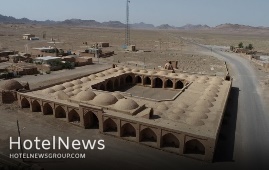
Three Qajar-era (1789-1925) caravanserais in Tabas, eastern South Khorasan province, have recently been demarcated help their legal boundaries and properties, a local tourism official has said. “New boundaries have been defined for Khan, Chehel Payeh, and Deh-e Mohammad caravanserais in a bid to curb illegal constructions within their boundaries,” Parisa Jamshidi announced on Sunday. The caravanserais, which are among the candidates for a collective inclusion in UNESCO’S cultural heritage list, has been recently restored, the official noted. Over 70 billion rials ($1.7 million at the official exchange rate of 42,000 rials per dollar) has been invested in the restoration projects of the historical inns so far, she added. Caravansary (also Caravanserai or Caravansaray) is a building that served as the inn of the Orient, providing accommodation for commercial, pilgrim, postal, and especially official travelers. According to Encyclopedia Iranica, from the number of surviving caravansaries and their sizes, it is clear that in Safavid and Qajar times there was a state architectural department that was specifically concerned with the construction of caravansaries and stations on the overland routes. Furthermore, in the cities, several caravansaries were erected as lodging houses, depots, and commercial offices in the vicinity of the bazaars. A typical caravansary consists of a square or rectangular plan centered around a courtyard with only one entrance and arrangements for defense if necessary. Whether fortified or not, it at least provided security against beasts of prey and attacks by brigands. Iran’s earliest caravanserais were built during the Achaemenid era (550 -330 BC). Centuries later, when Shah Abbas I assumed power from 1588 – to 1629, he ordered the construction of network caravanserais across the country. Such roadside inns were originally built in various epochs along ancient caravan routes in the Muslim world to shelter people, their goods, and animals. The former Silk Roads may be the most famous example dotted by caravanserais.
Create: Nov 3, 2021 Edit: Nov 3, 2021 Regional News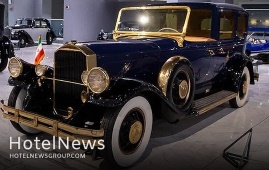
Following years of restoration and renovation, Iran Historical Car Museum in western Tehran has reopened its doors to the public, featuring a magnificent collection of rare classic, vintage, sports cars, carriages, and motorcycles.Highlights of the museum include a gold-plated limousine, the world’s only Panther-Laser car produced, a Silver Ghost Rolls-Royce once owned by the Qajar King, Ahmand Shah (r. 1909 – 1925), as well as a royal carriage belonging to Nasereddin Shah of Qajar.In an interview with the Tehran Times on Sunday, the director of the museum Mohammad Fa’al, said: “The 1922 Rolls-Royce, a Morris Oxford Bullnose, and a Fiat Tipo 519 constitute the three oldest cars of the collection.”“The building of the museum underwent restorations as of 2005 as you can see the images of the restoration of the building and cars have been installed on the walls of the museum. Moreover, we refurbished a dozen other cars from our treasury and added them to the newly-opened museum.”“The museum has four main halls, the first of which bears the oldest vehicles of the collection, amongst them the Rolls-Royce Silver Ghost that was belonging to Ahmad Shah Qajar,” he said. Hall 2 is dedicated to American and Mercedes-Benz vehicles, and Hall 3 is devoted to the official and ceremonial cars, which include various models of Rolls-Royces and Mercedes. Hall 4 is also dedicated to sports and super sports cars. In response to a question about the number of vehicles, the director said: “There are currently 102 cars in the treasury in addition to 55 cars that are currently on display.” “Of course, what you now see in here is not all our cars, and we have a treasury that acts as a support for the museum, and it has cars that are being renovated over time and replaced with these existing cars in order to preserve the charm of the museum.” The museum owns the largest collection of Mercedes-Benz 600 in the world. “We have the largest collection of Mercedes-Benz 600 in the world with 21 units. The Mercedes-Benz Museum itself has three units of the 600 model…. the Mercedes-Benz 600 itself is designed and built with different rooms and its function is only for ceremonies and this model has different rooms some having hardtop or custom-made sunroofs,” the director of the museum explained. He said that the museum owns all models of Mercedes-Benz 600, which is very unique. “Moreover, we have all models of Mercedes-Benz 600 that have been produced by the German company; four of which are on display here in the museum, and 17 are being kept inside the treasury.” Furthermore, Fa’al added 21 classic Rolls-Royces are being kept in the museum and its treasure trove. “Home to 21 [classic] Rolls-Royces, Iran Historical Car Museum is the second-largest treasure trove of those vehicles after the Rolls-Royce Museum.” Talking about the values of cars he explained, “all these cars are valuable and it is impossible to say which one is better. We can say which one is more beautiful and which has a more attractive design, but we cannot say which is more valuable.” “However, the classification of cars in terms of value depends on several factors: one is the age of the car, the other is its manufacturer brand and design technology. And there are decorative items used in cars. For instance, a car in which is gold plated and is decorated with jewelry is obviously more valuable than an ordinary one….” Responding to a question concerning restoration, Fa’al said all the processes of rebuilding cars are fully documented and all phases are photographed and evidence is available. The age of the classic cars According to Brinatica, the decade 1925–35 was notable not only for the appearance of many new small automobiles but also for the building of many ultra-large ones. The years from 1925 to 1948 are cited by collectors of automobiles as the “classic years,” a period that saw the rise of the luxurious fast motorcar to a peak it seems unlikely to reach again. The first name in this field was Rolls-Royce Ltd., founded in 1906. Most Rolls-Royce chassis are designed for limousine and large sedan bodies, but the firm once made a comparatively light car (called the Twenty), and it has throughout its history produced fast models in addition to its regular line—e.g., after World War II, the Continental, built under the Bentley Motors Ltd. label. Other motorcars of this type included the Hispano-Suiza of Spain and France; the Bugatti, Delage, Delahaye, Hotchkiss, Talbot (Darracq), and Voisin of France; the Duesenberg, Cadillac, Packard, and Pierce-Arrow of the United States; the Horch, Maybach, and Mercedes-Benz of Germany; the Belgian Minerva; and the Italian Isotta-Fraschini.
Create: Nov 3, 2021 Edit: Nov 3, 2021 Regional News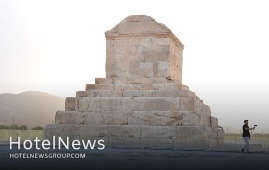
Iranian government has allocated a sum of 200 billion rials (about $4.7 million at the official exchange rate of 42,000 rials per dollar) to develop tourism infrastructure at the UNESCO-designated Pasargadae. A budget of 200 billion rials has been allocated to Pasargadae after President Ebrahim Raisi visited the Achaemenid site earlier in October, a senior tourism official, Javad Vahedi, said on Friday. The Pasargadae complex, as a magnificent World Heritage site, has a high tourism potential in the field of cultural and historical tourism, and we must plan to attract more tourists,” the official explained. Situated about 50 km north of Persepolis, Pasargadae was the first dynastic capital of the Achaemenid Empire, founded by Cyrus II the Great, in Pars, the homeland of the Persians, in the 6th century BC. Its palaces, gardens, and the mausoleum of Cyrus are outstanding examples of the first phase of royal Achaemenid art and architecture and exceptional testimonies of Persian civilization. The UNESCO World Heritage site is also home to a complex water supply system for the time that comprises cisterns, tunnels, underground canals, and ducts, which are locally known as qanats. It is believed that the development of qanats began about 2,500 or 3,000 years ago in Persia (Iran), and the technology spread eastward to Afghanistan and westward to Egypt. Although new qanats are seldom built today, many old qanats are still used in Iran and Afghanistan, chiefly for irrigation. The 160-ha archaeological site of Pasargadae presents some of the earliest manifestations of Persian art and architecture. It includes, among other monuments, the compact limestone tomb on the Morgab plain that once held Cyrus the Great’s gilded sarcophagus; Tall-e Takht (“Solomon’s Throne”), a great fortified platform built on a hill and later incorporated into a sprawling citadel with substantial mud-brick defenses; and the royal ensemble, which consists of several palaces originally located within a garden layout (the so-called “Four Gardens”). Pasargadae became a prototype for the Persian Garden concept of four quadrants formally divided by waterways or pathways, its architecture characterized by refined details and slender verticality. Pasargadae stands as an exceptional witness to the Achaemenid civilization. The vast Achaemenid Empire, which extended from the eastern Mediterranean and Egypt to the Hindus River in India, is considered the first empire to be characterized by a respect for the cultural diversity of its peoples. This respect was reflected in the royal Achaemenid architecture, which became a synthesized representation of the empire’s different cultures. Pasargadae represents the first phase of this development into a specifically Persian architecture which later found its full expression in the city of Persepolis.
Create: Oct 31, 2021 Edit: Oct 31, 2021 Regional News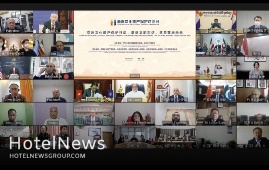
The Islamic Republic of Iran is prepared to offer expertise for the conservation of historical monuments and relics in Asia. On Thursday, Hadi Ahmadi-Roueeni, a senior official with the Ministry of Cultural Heritage, Tourism and Handicrafts announced the country’s readiness to share experience for the preservation of historical monuments with Asian countries, Iran Press reported. Establishing a fund to protect endangered cultural heritage in Asia and border-free associations of professionals in Asia as well as sharing experiences among the continental expert community would improve the conservation of the legacies, the official explained. He also called on all countries to join hands in various realms of political, academic, and professional levels to help restore the endangered historical legacies in countries suffering such problems as war, unrest, and occupation. Ahmadi-Roueeni made the remarks on Thursday on the second day of the first forum of “Asian Dialogue for Cultural Heritage Conservation” which was virtually held in China. The biggest Asian cultural heritage event is hosted by China on October 27 and 28 with the slogan of “Promoting Dialogue among Civilizations and Shaping the Future of the Asian”. According to organizers, the dialogue aims to move forward with the Asian Initiative for Cultural Heritage Conservation and open a new chapter for exchanges and mutual learning among Asian civilizations. Senior officials from 36 Asian countries and five international organizations including UNESCO, the International Council of Museums, and the International Council on Monuments and Sites participated in the conference in the form of an online meeting, Global Times reported. At the conference, the Asian Alliance for Cultural Heritage Conservation was jointly initiated by 10 Asian countries – China, Iran, Armenia, Cambodia, the Democratic People's Republic of Korea, Kyrgyzstan, Pakistan, Syria, the United Arab Emirates, and Yemen – was officially established. According to data from the UNESCO World Heritage Center, about 50 percent of the world’s endangered world cultural heritage sites are located in Asia. “Preserving our heritage is not a luxury – it is a prerequisite for ensuring that future generations can inherit an identity, a history, a voice, and a sense of ownership of their past and future,” said Xing Qu, deputy director-general of UNESCO. Xing expressed thanks to China for organizing the event and for helping to address the challenges facing cultural heritage. The ceremony also set up the Asian Fund for Cultural Heritage Conservation as a special fund to support programs and projects in conservation, research, and joint archaeology concerning cultural heritage conservation in Asia.
Create: Oct 31, 2021 Edit: Oct 31, 2021 Regional News
Cycas Hospitality, the award-winning pan-European operator, has signed a deal to operate London Town Group’s portfolio of upscale boutique hotels in the UK capital. The London Town Group of Companies, founded by Koolesh Shah, is one of the UK’s leading, privately-held real estate and energy investment companies. The agreement sees Cycas welcome its first two Mercure-branded hotels – part of Accor – to its portfolio. While the 72-room Mercure London Hyde Park – set within a Grade II listed building – recently completed a multi-million-pound refurbishment, the 86-room Mercure London Paddington is scheduled to start a fully renovation programme next year. As part of the extensive works, the hotel will upgrade its ground floor food and beverage facilities and transform its top floor into a rooftop bar.As Cycas’s seventh IHG-branded property, the 64-room Hotel Indigo London Paddington becomes its first Hotel Indigo in London and joins Hotel Indigo Dundee as its second in the UK. All three properties offer a wide range of dining options, meetings facilities and state-of-the-art fitness centres, all just a short walk from Hyde Park and Paddington Station, whose access will be further boosted with next year’s opening of Crossrail and the Elizabeth Line. Cycas has appointed Tanja Furby as Cluster General Manager for the three London hotels. A seasoned operator who has worked across a wide range of leading hospitality brands, Tanja’s commercial skills, leadership and local knowledge will help Cycas maximise each property’s customer offering. Koolesh Shah, Founder of London Town Group, said “As our business diversifies and grows, I felt now was the time to bring on board a recognised industry leader in hotel operations to partner on the transformation journey of our hotels. “We’ve always prided ourselves on our collection of leading branded-boutique hotels, and we’re confident that Cycas’s track-record in delivering the highest hospitality standards will ensure we can continue to give our guests the best possible experience.” Matt Luscombe, Chief Executive Officer at Cycas Hospitality, said: “I’ve known and admired Koolesh and his team for many years, since he opened the first Hotel Indigo outside of North America in 2009. Over the last decade, London Town Group has been synonymous with commercial and operational excellence. “With their central locations and exceptional transport links, these three hotels are ideally positioned to capitalise on the recovery in business and leisure travel. We’re proud and excited to begin this partnership together. The deal follows continued expansion for Cycas Hospitality, which has now opened or taken over 17 hotels in 12 months, despite the challenges posed by the Covid-19 pandemic,
Create: Oct 31, 2021 Edit: Oct 31, 2021 International News
The Ritz-Carlton Hotel Company, L.L.C. is excited to announce the debut of The Ritz-Carlton, Mexico City, providing discerning travelers with a new way to discover one of the world’s most dynamic destinations. Transforming the city’s skyline and sitting amongst the country’s tallest buildings, the hotel is centrally located along the iconic Paseo de Reforma and showcases uninterrupted views of the famed Chapultepec Park. Featuring the legendary service of the brand’s Ladies and Gentlemen, each detail of the hotel is thoughtfully designed to immerse guests in the city’s rich culture and offer a unique perspective on this beloved destination. Featuring unparalleled service, The Ritz-Carlton, Mexico City celebrates legendary Mexican hospitality and offers guests a highly personalized experience. The hotel features a wide range of carefully curated amenities designed for cultural discovery and epicurean adventures or business travel, including The Ritz-Carlton Club® Lounge with an exclusive Club Concierge, a heated indoor swimming pool, large fitness center with state-of-the-art equipment and a signature Ritz-Carlton Spa with six luxurious treatment rooms. Bringing the destination to life in a unique way, The Ritz-Carlton Spa thoughtfully sources local ingredients and botanicals, which are then coupled with the healing and spiritual traditions of Mexico City’s Aztec culture. In addition to relaxing and rejuvenating treatments, the spa features an assortment of wellness areas, including steam rooms, saunas, and a timeless capsule room. Dining at Samos, the Mediterranean inspired restaurant on the 38th floor of The Ritz-Carlton, Mexico City, guests can enjoy cuisine featuring dynamic local flavors for a one-of-a-kind experience. Bringing vast luxury experience and expertise in Mexican, Italian, French, Peruvian and Argentinian cuisines, Chef Jonathan Felix has carefully created each dish to offer a culinary journey where flavors and sensations are elevated with every bite. The epicurean experiences continue through the dessert course with delicate sweets like Nido, an airy mango and passion fruit mousse encased in white chocolate and cradled by a spun sugar nest. The Ritz-Carlton, Mexico City also offers more than 4,300 square feet of meeting space with floor to ceiling windows overlooking Chapultepec Park, ideally suited for a variety of events from meetings to celebratory occasions. The spaces have been designed to foster inspiration and connection whether a large gathering in the ballroom or an intimate board meeting.
Create: Oct 31, 2021 Edit: Oct 31, 2021 International News
The Islamic Republic of Iran should benefit from World Cup as a considerable opportunity to promote its distinctive travel attractions, the deputy tourism minister has said. "With the World Cup being held in a neighboring country, Iran can benefit from this important event, which if carefully planned, can bring significant wins for various sectors, especially the tourism industry in the country," CHTN quoted Ali-Asghar Shalbafian as saying on Wednesday. The geographical position of Iran and its unique tourist attractions make it a potential destination for the World Cup spectators, the official added. Therefore, proper policy-making and management in collaboration with the private sector can pave the way for the widespread use of this event, he noted. Increasing the number of flights between Iran and Qatar during the event, which will be held from November 21 to December 18, 2022, as well as showcasing and introducing distinctive tourist attractions of the country to the spectators at this event are on the agenda of the tourism ministry, he explained. Back in September, Cultural Heritage, Tourism, and Handicrafts Minister Ezzatollah Zarghami announced the issuance of tourist visas and the flow of foreign tourists to Iran would resume as per President Ebrahim Raisi’s order following 19 months of suspension. However, now that the tourist visas are once again being issued to cultivate good grounds of hope for travel insiders. Months of steep recession has taken its toll. Many travel insiders, hoteliers, and tour operators have faced big dilemmas such as bankruptcy, unemployment, debts, and the prospects of not being competitive on the international level. Meanwhile, the number of people testing positive for COVID-19 has continued to fall in the Islamic Republic, curbing a stubborn fifth wave of the pandemic, which has seen daily mortalities of up to 700 in recent weeks. As of September 22, the figure dropped to below 300 as the government has devoted a great deal of effort to vaccinate citizens against the nasty virus. Some experts believe Iran is still somehow “unknown” for many potential travelers due to Western “media war”. Several estimates have been released so far on the extent of the tourism-related losses incurred by the pandemic. Only months into the outbreak, Zarghami’s predecessor, Ali-Asghar Mounesan, lamented that the number of foreign travelers to Iran was drastically plunged due to the pandemic. Tourism of the country was growing before the corona [outbreak], its revenues reached $11.7 billion in 2019, which accounted for 2.8% of GDP, nearing the average share of tourism in the world GDP, which was 3.2 percent,” Mounesan said. He added 8.7 million foreign nationals visited Iran during the [Iranian] year (1398), adding that Iran was ranked as the second fastest-growing country in tourism based on data compiled by the World Tourism Organization. Experts expect Iran to achieve a tourism boom after coronavirus contained, believing its impact would be temporary and short-lived for a country that ranked the third fastest-growing tourism destination in 2019. The Islamic Republic expects to reap a bonanza from its numerous tourist spots such as bazaars, museums, mosques, bridges, bathhouses, madrasas, mausoleums, churches, towers, and mansions, of which 26 are inscribed on the UNESCO World Heritage list. Under the 2025 Tourism Vision Plan, Iran aims to increase the number of tourist arrivals from 4.8 million in 2014 to 20 million in 2025.
Create: Oct 31, 2021 Edit: Oct 31, 2021 Regional News
